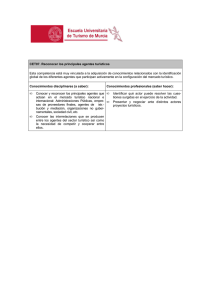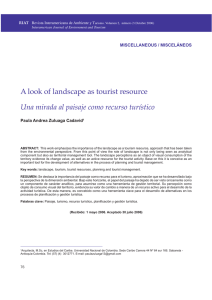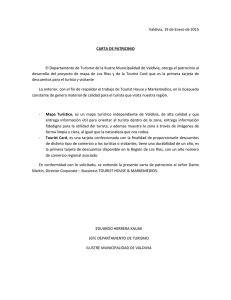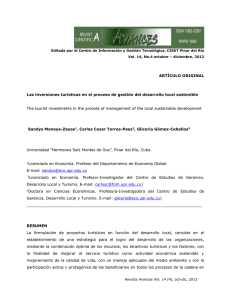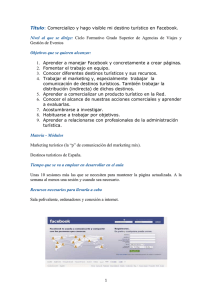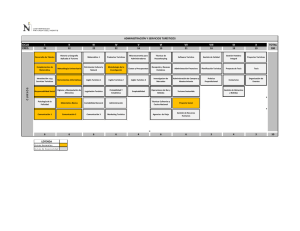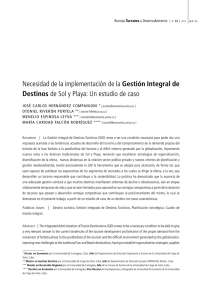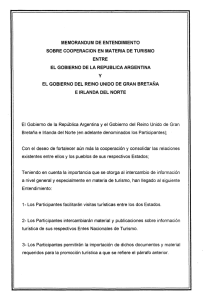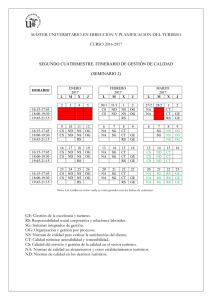Diversificación y diferenciación de los destinos turísticos
Anuncio
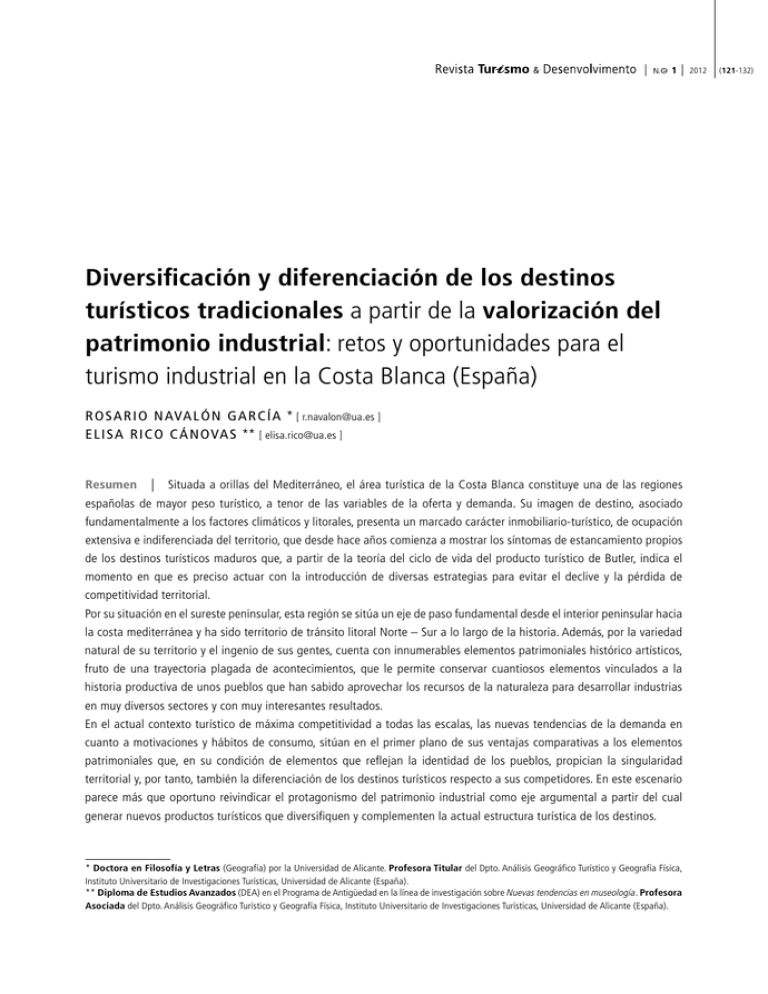
| | Diversificación y diferenciación de los destinos turísticos tradicionales a partir de la valorización del patrimonio industrial: retos y oportunidades para el turismo industrial en la Costa Blanca (España) ROSARIO NAVALÓN GARCÍA * [ r.navalon@ua.es ] ELISA RICO CÁNOVAS ** [ elisa.rico@ua.es ] Resumen | Situada a orillas del Mediterráneo, el área turística de la Costa Blanca constituye una de las regiones españolas de mayor peso turístico, a tenor de las variables de la oferta y demanda. Su imagen de destino, asociado fundamentalmente a los factores climáticos y litorales, presenta un marcado carácter inmobiliario-turístico, de ocupación extensiva e indiferenciada del territorio, que desde hace años comienza a mostrar los síntomas de estancamiento propios de los destinos turísticos maduros que, a partir de la teoría del ciclo de vida del producto turístico de Butler, indica el momento en que es preciso actuar con la introducción de diversas estrategias para evitar el declive y la pérdida de competitividad territorial. Por su situación en el sureste peninsular, esta región se sitúa un eje de paso fundamental desde el interior peninsular hacia la costa mediterránea y ha sido territorio de tránsito litoral Norte – Sur a lo largo de la historia. Además, por la variedad natural de su territorio y el ingenio de sus gentes, cuenta con innumerables elementos patrimoniales histórico artísticos, fruto de una trayectoria plagada de acontecimientos, que le permite conservar cuantiosos elementos vinculados a la historia productiva de unos pueblos que han sabido aprovechar los recursos de la naturaleza para desarrollar industrias en muy diversos sectores y con muy interesantes resultados. En el actual contexto turístico de máxima competitividad a todas las escalas, las nuevas tendencias de la demanda en cuanto a motivaciones y hábitos de consumo, sitúan en el primer plano de sus ventajas comparativas a los elementos patrimoniales que, en su condición de elementos que reflejan la identidad de los pueblos, propician la singularidad territorial y, por tanto, también la diferenciación de los destinos turísticos respecto a sus competidores. En este escenario parece más que oportuno reivindicar el protagonismo del patrimonio industrial como eje argumental a partir del cual generar nuevos productos turísticos que diversifiquen y complementen la actual estructura turística de los destinos. * Doctora en Filosofía y Letras (Geografía) por la Universidad de Alicante. Profesora Titular del Dpto. Análisis Geográfico Turístico y Geografía Física, Instituto Universitario de Investigaciones Turísticas, Universidad de Alicante (España). ** Diploma de Estudios Avanzados (DEA) en el Programa de Antigüedad en la línea de investigación sobre Nuevas tendencias en museología. Profesora Asociada del Dpto. Análisis Geográfico Turístico y Geografía Física, Instituto Universitario de Investigaciones Turísticas, Universidad de Alicante (España). 2012 (121-132) 121 122 RT&D | | 2012 | GARCÍA e CÁNOVAS No obstante, la oportunidad de llevar a cabo la valorización turística del patrimonio industrial, como materia prima para la creación de ofertas culturales que deriven en productos turísticos atractivos y viables, se convierte en un verdadero reto, cuando se analizan todas las variables que han de estar presentes en la configuración de un sistema turístico adecuado para que éstas lleguen a ser una realidad. Los recursos patrimoniales por sí mismos no pueden asimilarse a productos turísticos, y las estrategias a desarrollar implican la participación de muchos factores, internos y externos, del sistema turístico y del consenso de multitud de agentes en la creación de una oferta turística vinculada al patrimonio industrial. A lo largo de estas páginas, se pretende describir la situación actual que respecto al desarrollo del turismo industrial presenta el ámbito turístico de la Costa Blanca, como ejemplo de un diagnóstico común a muchos otros espacios turísticos consolidados. Analizar las potencialidades y presentar un diagnóstico de la situación a partir de una metodología participativa, es el arranque de esta aportación que concluye con una serie de propuestas de actuación que ofrecen las pautas de trabajo para lograr, en primer lugar la creación y después la viabilidad, de un producto de turismo industrial en la Costa Blanca alicantina. Palabras-claves | Turismo industrial, Destinos turísticos consolidados, Patrimonio industrial, Industria viva. Abstract | Situated in the Mediterranean seaboard, the tourist area of the Costa Blanca constitutes one of the Spanish regions of greater tourist weight, according to offer and demand variables. The destination image, associated fundamentally to climatic and coastal factors, presents a marked residential-tourist character of expansionary occupation of the territory, that for several years begins to show the symptoms of own stagnation of the mature tourist destinations that, from the theory of the Butler’s life cycle of the tourist product, indicates the precise moment that it is necessary to act with the introduction of diverse strategies to avoid the decline and the loss of territorial competitiveness. This region, due to its geographic location, its natural variety and its people creativity, has innumerable elements of the historical heritage, fruit of a full path of events, that allows it to conserve numerous elements related with the productive history of some villages that have been known, taking advantage of the resources of the nature to develop industries in diverse sectors and with interesting results. In the current tourist context of maximum competitiveness in all scales, the new tendencies of the demand in the motivations and forms of consumption, situate in the first plane of comparative advantages the heritage elements that reflect the identity of the villages and, therefore, also the differentiation of the tourist destinations with regard to its competitors. In this stage, there seems to be the correct time to claim the leadership of industrial heritage and generate new tourist products that diversify and complement the current tourist structure of the destinations. Nevertheless, the opportunity to carry out the tourist valorisation of the industrial heritage, like prime matter for the creation of attractive and viable cultural offers, turns into a true challenge, when they analyse all the variables that have to be present in the planning of a suitable tourist system so it can became a reality. The heritage resources, by itself, cannot be assimilated into tourist products, and the strategies to attain it involve the participation of a lot of factors of the tourist system and of the consensus of crowd of agents in the creation of a tourist offer linked to the industrial heritage. Along these pages, we intend to describe the current situation with regard to the development of the industrial tourism in Costa Blanca, like an example of a common diagnostic to a lot of other tourist spaces consolidated. To analyse the potentialities and present a diagnostic of the situation from a participatory methodology, is the start of this contribution that concludes with a series of proposals of performance that offer the guidelines of work to attain, in the first place the creation and afterwards the feasibility, of a product of industrial tourism in the Alicante Costa Blanca. Keywords | Industrial tourism, Consolidated tourist destinations, Industrial heritage, Alive industry.

